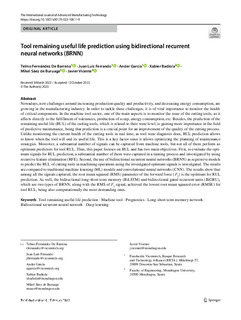| dc.rights.license | Attribution 4.0 International | * |
| dc.contributor.author | Badiola, Xabier | |
| dc.contributor.author | Saez de Buruaga, Mikel | |
| dc.contributor.author | Vicente, Javier | |
| dc.contributor.other | Fernandez de Barrena, Telmo | |
| dc.contributor.other | Ferrando, Juan Luis | |
| dc.contributor.other | García, Ander | |
| dc.date.accessioned | 2023-03-01T20:20:16Z | |
| dc.date.available | 2023-03-01T20:20:16Z | |
| dc.date.issued | 2023 | |
| dc.identifier.issn | 1433-3015 | en |
| dc.identifier.other | https://katalogoa.mondragon.edu/janium-bin/janium_login_opac.pl?find&ficha_no=171577 | en |
| dc.identifier.uri | https://hdl.handle.net/20.500.11984/6024 | |
| dc.description.abstract | Nowadays, new challenges around increasing production quality and productivity, and decreasing energy consumption, are growing in the manufacturing industry. In order to tackle these challenges, it is of vital importance to monitor the health of critical components. In the machine tool sector, one of the main aspects is to monitor the wear of the cutting tools, as it affects directly to the fulfillment of tolerances, production of scrap, energy consumption, etc. Besides, the prediction of the remaining useful life (RUL) of the cutting tools, which is related to their wear level, is gaining more importance in the field of predictive maintenance, being that prediction is a crucial point for an improvement of the quality of the cutting process. Unlike monitoring the current health of the cutting tools in real time, as tool wear diagnosis does, RUL prediction allows to know when the tool will end its useful life. This is a key factor since it allows optimizing the planning of maintenance strategies. Moreover, a substantial number of signals can be captured from machine tools, but not all of them perform as optimum predictors for tool RUL. Thus, this paper focuses on RUL and has two main objectives. First, to evaluate the optimum signals for RUL prediction, a substantial number of them were captured in a turning process and investigated by using recursive feature elimination (RFE). Second, the use of bidirectional recurrent neural networks (BRNN) as regressive models to predict the RUL of cutting tools in machining operations using the investigated optimum signals is investigated. The results are compared to traditional machine learning (ML) models and convolutional neural networks (CNN). The results show that among all the signals captured, the root mean squared (RMS) parameter of the forward force (Fy) is the optimum for RUL prediction. As well, the bidirectional long-short term memory (BiLSTM) and bidirectional gated recurrent units (BiGRU), which are two types of BRNN, along with the RMS of Fy signal, achieved the lowest root mean squared error (RMSE) for tool RUL, being also computationally the most demanding ones. | en |
| dc.description.sponsorship | Gobierno Vasco-Eusko Jaurlaritza | es |
| dc.language.iso | eng | en |
| dc.publisher | Springer | en |
| dc.rights | © 2023 Springer | en |
| dc.rights.uri | http://creativecommons.org/licenses/by/4.0/ | * |
| dc.subject | Tool remaining useful life prediction | en |
| dc.subject | Machine tool | en |
| dc.subject | Prognostics | en |
| dc.subject | Long-short term memory network | en |
| dc.subject | Bidirectional recurrent neural network | en |
| dc.subject | Deep learning | en |
| dc.subject | ODS 9 Industria, innovación e infraestructura | es |
| dc.title | Tool remaining useful life prediction using bidirectional recurrent neural networks (BRNN) | en |
| dcterms.accessRights | http://purl.org/coar/access_right/c_abf2 | en |
| dcterms.source | The International Journal of Advanced Manufacturing Technology | en |
| local.contributor.group | Mecanizado de alto rendimiento | es |
| local.description.peerreviewed | true | en |
| local.identifier.doi | https://doi.org/10.1007/s00170-023-10811-9 | en |
| local.relation.projectID | info:eu-repo/grantAgreement/GV/Elkartek 2020/KK-2020-00103/CAPV/Herramientas de corte inteligentes sensorizadas mediante recubrimientos funcionales/INTOOL II | en |
| local.relation.projectID | info:eu-repo/grantAgreement/GV/Elkartek 2021/KK-2021-00111/CAPV/Arquitectura embebida para nuevas aplicaciones edge computing/ERTZEAN | en |
| local.contributor.otherinstitution | https://ror.org/0023sah13 | es |
| oaire.format.mimetype | application/pdf | |
| oaire.file | $DSPACE\assetstore | |
| oaire.resourceType | http://purl.org/coar/resource_type/c_6501 | en |
| oaire.version | http://purl.org/coar/version/c_970fb48d4fbd8a85 | en |








